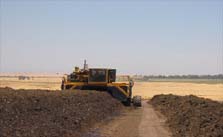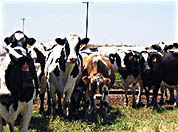Contact Pacific Southwest Waste Program
Pacific Southwest, Region 9
Serving: Arizona, California, Hawaii, Nevada, Pacific Islands, Tribal Nations
How did 70 billion pounds of manure become a valuable resource?
National Links
Related Information

A Merced County, California landfill mixes manure with green waste
Finding ways to manage such a staggering amount of waste is challenging, especially considering the high costs of hauling and disposal and limited landfill space. If this waste is not properly managed, it can contaminate water supplies and threaten public health.
A recent EPA pilot project demonstrated that manure can actually be a valuable resource. Sustainable Conservation, a San Francisco-based non-profit, used an EPA grant to analyze the benefits of mixing dairy manure with urban “green waste.” Green waste includes organic matter which naturally decays, such as leaves, grass cuttings and yard trimmings.

Central Valley Dairy Cows
The resulting mixture “co-compost” is good for the soil and the environment. Co-compost has the ability to help regenerate poor soils and reduce or eliminate the need for chemical fertilizers.
- In one day, a cow generates 120 pounds of manure
- Dairies in California create 85% more solid waste than the state's 36 million residents.
- California dairies produce 70 billion pounds of manure each year.
Although raw manure can be used as fertilizer, the high levels of nutrients and pathogens can contaminate water and threaten public health. California’s State Water Board estimates that nitrates have contaminated 600 miles of drinking water in the Central Valley. In addition, the pathogens in raw manure, such as E-Coli or Salmonella, pose a public health risk.
Using co-compost as a fertilizer provides dairy farmers with more economic and environmental benefits than simply using raw manure:
- co-compost is safer for crops -- the high temperatures used in the process destroy harmful pathogens and other contaminants found in manure.
- co-compost is usually cheaper to use than commercial fertilizers because it's a natural product.
- co-compost is better for plants because it has more organic material -- specifically, co-compost has 13% more nitrogen, and double the amount of phosphorus, and potassium and sulfur than is found in manure.
In our pilot project, dairy farmers were able to cost effectively recycle their waste and reduce nitrate contamination of groundwater in the area. The cities were able to enhance the economic value of their compost, reduce the amount of material sent to the landfill, and provide an important service to their agricultural community.
